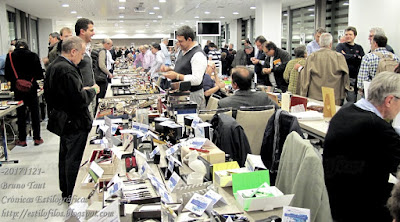The better known of them is the Japanese eyedropper, inki-dome system, although the original invention belonged to Onoto (De la Rue). Another such system is the hoshiawase (star system) invented by Pilot in the early 1920s. But there is more.
Prior to the system of the stars, Pilot entered the market –as a late comer in the Japanese context— with another system: the naikan shiki (内管式), or inner tube system. This consists of a modified screw –made of ebonite— attached to the section of the pen. By tightening or losing up that screw, the ink flow could be interrupted or open through the internal channels in that screw. The obvious inconvenient was the need to open the pen –the ink deposit— to operate this ink-stained screw. However, this system was effective in sealing the ink deposit.
Pilot developed and marketed this system probably trying to offer a novelty in a market already mature, with two very active pen companies –SSS and Nobuo Ito’s Swan–, and a number of imports from Europe and the US. The naikan shiki was short lived: only a couple of years around 1920.
As for the rest, this eyedropper pen is made of chased ebonite and implements a size 2 nib made of 14 K gold, although it might not be the original nib of this pen. The clip this particular unit sports is a later addition.

On the nib, the inscription says "14 KT GOLD / "PILOT" / < 2 > / MADE IN / JAPAN". However, the style of the inscription is probably too new, thus showing it is a replacement nib. On the text entitled N. M & Co. we can see a similar pen whose nib carries a much simpler engraving.
These are the dimensions of the pen:
Length closed: 139 mm
Length open: 131 mm
Length posted: 179 mm
Diameter: 12 mm
Weight (dry): 17.4 g

On the chased barrel, '"PILOT" / FOUNTAIN PEN / N. M. & Co.'. The company logo is on the left hand side. It shows the well-known lifebuoy encircling an N.

On the barrel end, a mysterious inscription: "P3CH". We had already seen it on another Pilot pen of the time.
Not all innovations work… However, the Japanese industry has never been shy to try different technical solutions on nibs and filling systems.
But short lived systems like this make the day of many a collector.
And on my side, I must add a correction to an old Chronicle.
My thanks to Mr. Sugimoto and Mr. Furuya.
Romillo Nervión – Sailor Blue Iron
Bruno Taut
Nakano, February 7th 2018
etiquetas: Pilot, soluciones técnicas
Bruno Taut
Nakano, February 7th 2018
etiquetas: Pilot, soluciones técnicas























































